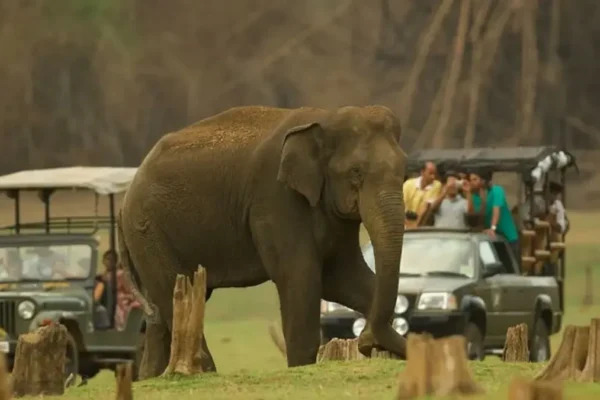The Singalila National Park in West Bengal is a dream destination for wildlife enthusiasts and nature lovers. Nestled in the Eastern Himalayas, this park is a treasure trove of biodiversity, home to some of the world’s rarest species, including the adorable and elusive red panda. Known for its bamboo groves, rhododendron forests, and breathtaking views of snow-capped peaks, Singalila offers an unforgettable adventure for those looking to track this charming yet elusive creature. Here’s your ultimate guide to trekking through Singalila in search of the red panda, brought to life by the expertly curated Red Panda Expedition by Just Nature Expeditions.
The Mystique of the Red Panda
Often referred to as the “firefox” of the Himalayas, the red panda is a small mammal with a reddish-brown fur coat, bushy tail, and an adorable face marked by distinctive white facial markings. Though they may resemble raccoons or small bears, red pandas are in a unique family of their own called Ailuridae. Sadly, due to habitat loss, poaching, and climate change, they are classified as an endangered species, making spotting one in the wild a rare and precious experience.
The Trekking Experience: What to Expect
Singalila National Park, located at an elevation ranging from 7,000 to 12,000 feet, is a paradise for trekkers. The journey often starts from the quaint village of Manebhanjan, progressing through picturesque trails flanked by blooming rhododendrons, magnolias, and ancient oak trees. Treks usually last 4-5 days, covering key points like Tumling, Kalapokhri, and Sandakphu—the highest point in West Bengal with stunning views of Mt. Everest and Kanchenjunga.
Expect to trek through misty forests, bamboo thickets, and moss-covered trails. The park’s serene landscape is complemented by the symphony of chirping birds, rustling leaves, and the occasional call of distant wildlife, setting the perfect ambiance for your red panda quest. With Just Nature Expeditions, you don’t have to worry about planning the logistics. From expert local guides to comfortable accommodations, every detail is meticulously managed to ensure you have a seamless and enriching experience.
Tips for Spotting the Elusive Red Panda
Spotting a red panda requires patience, a keen eye, and a bit of luck. Here are some tips to improve your chances:
- Hire a Local Guide: Engaging a local guide who knows the terrain and red panda behaviour is crucial. When you book with Just Nature Expeditions, you’re paired with seasoned guides who can interpret subtle signs like claw marks, droppings, or food remnants that might indicate a red panda’s presence.
- Early Mornings & Late Afternoons: Red pandas are most active during dawn and dusk. Just Nature Expeditions schedules treks around these times when the pandas are likely to be foraging for food, maximizing your chances of a sighting.
- Focus on Bamboo Groves: Red pandas have a diet that mainly consists of bamboo shoots and leaves. Be extra vigilant when passing through bamboo thickets, which are prime spots for sightings.
- Stay Quiet and Keep Your Distance: These animals are shy and easily spooked by noise. Move quietly, avoid sudden movements, and maintain a respectful distance to increase your chances of a sighting.
- Look Up: Red pandas are arboreal, meaning they spend a lot of time in trees. Keep an eye on tree branches, especially those close to bamboo patches.
Other Wildlife Encounters in Singalila
While the red panda is the star of the show, Singalila’s rich biodiversity means you’re in for a wildlife spectacle. You might encounter Himalayan black bears, clouded leopards, barking deer, and yellow-throated martens. The park is also a birdwatcher’s paradise with over 300 species, including the satyr tragopan, blood pheasant, and Himalayan griffon.
Best Time to Visit
The best time to track red pandas in Singalila is between October and November or March and May when the weather is pleasant, and visibility is clear. During these months, the forest comes alive with blooming flowers, making the trekking experience even more magical.
What to Pack for the Trek
- Warm Layers: Temperatures can drop significantly, especially at night. Pack thermal layers, a warm jacket, and gloves.
- Comfortable Trekking Shoes: Invest in good quality trekking boots with a firm grip, as the trails can be slippery.
- Binoculars & Camera: Essential for wildlife spotting. A zoom lens will help you capture distant red pandas without disturbing them.
- Reusable Water Bottle: Staying hydrated is crucial at high altitudes. Carry a refillable water bottle or hydration pack.
- Snacks: Energy bars, nuts, and dried fruits are handy for quick energy boosts during the trek.
Responsible Trekking: Protecting the Red Panda Habitat
While the thrill of spotting a red panda is unmatched, it’s essential to trek responsibly. Stick to designated trails, avoid disturbing wildlife, and respect the local communities. Singalila’s fragile ecosystem needs our care to ensure that the red panda and other species continue to thrive for generations to come.When you choose Just Nature Expeditions, you can be confident that your trek is conducted with the highest standards of environmental responsibility and local engagement. The expedition ensures that your adventure leaves a positive impact on the community and the habitat.
Tracking the red panda in Singalila is more than just a wildlife adventure; it’s a journey through one of the most pristine landscapes on the planet. With every step, you’re immersed in nature’s grandeur, breathing in the crisp mountain air, and witnessing the delicate balance of life in the high Himalayas. Whether you spot a red panda or simply soak in the serenity of the forest, the experience is bound to leave you with memories that last a lifetime.
With Just Nature Expeditions by your side on your Red Panda Expedition, you can embark on this wildlife adventure with the assurance that every detail is taken care of—from expert guidance to immersive experiences that bring you closer to the magic of the wild.





